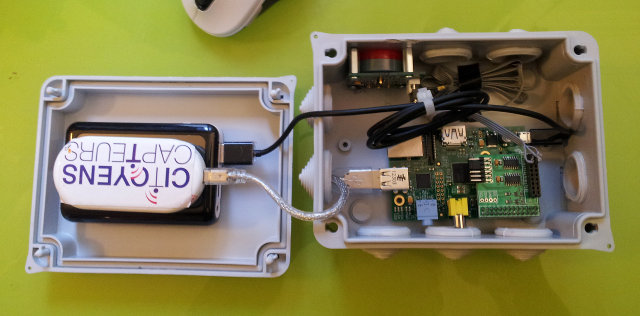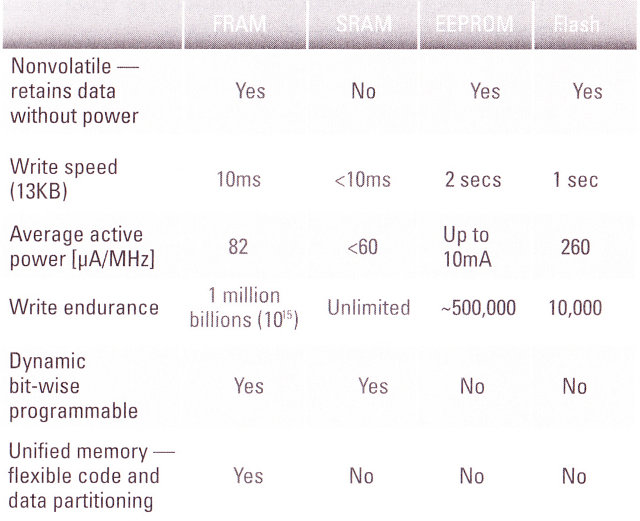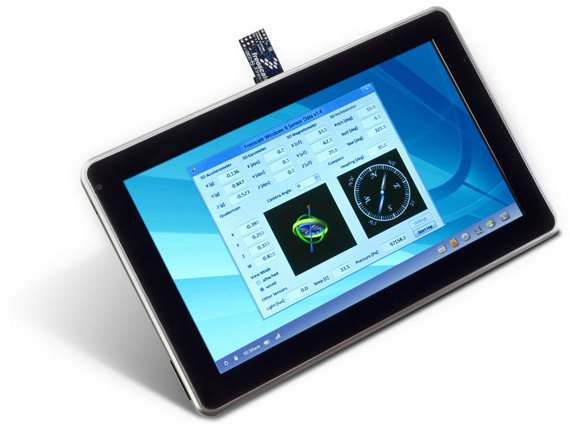“Le Labo Citoyen” is a recently founded French non-profit organization aimed at “promoting and experimenting with innovating and free technologies for the citizens and the environment”. Their first project is to gather pollution data (NO2, O3, and SO2 levels) in Paris using 2 (soon to be) open source components: Gasser – Self-contained mobile sensor currently powered by the Raspberry Pi ThingStream – Open source IoT datastore which should be similar to iDigi Cloud, except you can just store data in your own server or on “Le Labo Citoyen” servers. Gasser has four main parts: Sensor(s) – Alphasense B4-series sensors (black and red component in the top left of the main box) with accuracy of up to <10 ppb (parts-per-billion). Cost: ~110 Euros. They currently only use the NO2 (nitrogen dioxide) sensor. ADC & Computer – Raspberry Pi (Cost: ~30 Euros) & Delta-Sigma ADC (Cost: ~30 Euros). Communication Medium – Huawei […]
FRAM (Ferroelectric Random Access Memory) and Texas Instruments MSP430FR57xx MCUs
I’ve recently received a complementary book entitled “Texas Instruments FRAM MCUs for DUMMIES” sent by Mouser, that provides technical and practical information about FRAM (Ferroelectric Random Access Memory) – pronounced F-RAM – and Texas Instruments MSP430FR57xx MCU series which makes use of this relatively new type of memory. FRAM is a non-volatile memory with power and write speed & endurance characteristics that almost matches SRAM capabilities, and leave traditional Flash and EEPROM memory in the dust in terms of performance, as you can see from the table and diagram below. At constant speed, FRAM consumes 250x less than Flash/EEPROM. Please note the FRAM write speed also depends on the MCU used, and a MCU @ 8MHz can write the FRAM @ 1400 kBps (Source: TI). However, you won’t see this type of memory in devices like smartphones anytime soon because the maximum size currently manufactured is 1MB, density is higher […]
Freescale 12-axis Xtrinsic Sensor Platform Technology for Windows 8 / RT
Freescale announced the Xtrinsic Sensor Platform, a 12-axis sensor development reference platform for Windows 8. This 12-axis sensor platform includes several sensors by Freescale and other companies: Xtrinsic MMA8451Q 3-axis accelerometer Xtrinsic MAG3110 3-axis magnetometer Xtrinsic MPL3115A2 precision altimeter, pressure, and temperature sensor An analog ambient light sensor A selection of 3D gyroscopes are also supported This platform is powered by Freescale ColdFire+ MCF51JU128VHS MCU which combines, configures and processes sensor data with Freescale sensor fusion software to match the requirements of Windows 8/RT. Xtrinic sensor platform communicates with the host device via USB. It does not requires extra drivers as it uses standard HID drivers. You can watch the video below which is an introduction (including some technical details) and demo of the system. Strangely, I could not find a similar Freescale 12-axis reference design for Android or Linux, and I’m not sure why they would limit this hardware […]
Designing An Android Sensor Subsystem: Pitfalls and Considerations – Android Builder Summit 2012
Jen Costillo of Lab 126 discusses the Android sensor subsystem at the Android Builder Summit in February 2012. Abstract: This lecture will arm Android device architects with the tactical knowledge they need to navigate the Android Sensor subsystem and make knowledgeable design choices to improve user experience and improve battery performance. The talk will address: Hardware architecture and trade-offs including latency, power, and software architecture implications: Wake up events and power considerations Gesture Detection Algorithm processing location and considerations Testing methodologies (Creating tools to aid develop and collect data. This talk targets the kernel/firmware developer responsible for the sensor architecture. They should be familiar with kernel drivers, embedded systems, hardware bring up, Android services, and the C language. You can also download the presentation slides on linuxfoundation.org website. Jean-Luc Aufranc (CNXSoft)Jean-Luc started CNX Software in 2010 as a part-time endeavor, before quitting his job as a software engineering manager, and […]






